2015 KTM 1290 Super Adventure First Ride Review
From Super Duke to Super Adventure, KTM is 2 for 2
One year and a handful of months ago I was returning from Spain with the knowledge that KTM had constructed something special; the 1290 Super Duke R. The SDR went on to claim MO’s 2014 Bike of the Year award, as well as similar accolades from competing publications. If you read my First Ride Review of the SDR, this story will sound familiar. In what seems like déjà vu, I’m returning from Spain with the knowledge that KTM has constructed something special; the 2015 1290 Super Adventure.
2015 KTM 1290 Super Adventure
| Engine | 19.5/20 |
| Suspension/Handling | 14.5/15 |
| Transmission/Clutch | 9.25/10 |
| Brakes | 9.25/10 |
| Instruments/Controls | 4.25/5 |
| Ergonomics/Comfort | 9.5/10 |
| Appearance/Quality | 8.5/10 |
| Desirability | 9.0/10 |
| Value | 9.0/10 |
| Overall Score | 92.75/100 |
Having fashioned this new Adventure model around the SDR’s monstrously potent 1301cc 75° V-Twin, it should come as no surprise that the Super Adventure’s performance is impressive. Still, there are numerous ways in which an OEM can screw up a new model – especially when introducing first-time technology such as semi-active suspension. Aprilia did it with the Caponord last year, and we were largely unimpressed (see our Middleweight Sport-Touring Shootout). The Super Adventure’s semi-active WP fork and shock are, however, up to the task of bitch-slapping a curvy road straight.
Discuss this at our KTM Forum.
The 600 square-mile island of Gran Canaria rises to an elevation of nearly 6400 feet, with switchbacks crisscrossing the island’s interior, continuously rising and falling over its volcanic topography. For two days we explored the island, never once retracing our steps, and in the process racked up nearly as many vertical miles as horizontal ones. The 1290 Super Adventure, its chassis, semi-active suspension, and especially its engine met every challenge and thwarted every obstacle. I should caveat that no part of this press intro was conducted off-road. So, any impressions of its performance in the dirt will have to wait.
With the 1290 Super Adventure, Europe’s largest motorcycle manufacturer is flexing its technological muscle. The few gripes we had with the 1190 Adventure in our Battle Of The Adventures, such as no cruise control, no heated grips or heated seat, needing a more easily adjustable windscreen, have all been addressed with the 1290 model, and then some. The most important technology being the bike’s semi-active suspension.
Super Technologies | ||
|---|---|---|
| Semi-active Suspension | Heated Grips & Seat | Ride-by-Wire Throttle |
| LED Cornering Lights | Motorcycle Traction Control (MTC) | Tire Pressure Monitoring System (TPMS) |
| Cruise Control | Slipper Clutch | Hill Hold Control (optional) |
| ABS/Cornering-ABS (C-ABS) | Ride Modes | Motor Slip Regulation (optional) |
Similar to other semi-active suspension components, the WP units on the Super Adventure provide four settings: Comfort, Street, Sport and Offroad. Using the left handlebar-mounted switchgear a rider can, on the fly, toggle between the four, selecting the appropriate setting for the riding conditions. A welcome feature developed by WP is the anti-dive function, which maintains chassis neutrality instead of severely pitching forward through the fork’s stroke when the front brakes are applied.
Interestingly, KTM chose to have the most anti-dive in the Street setting, while allowing for more dive in Comfort and Sport settings. For Sport, the reasoning behind this decision is to provide more front end feel while allowing the rider to better finish a corner. Personally, I preferred the Street setting and its increased amount of anti-dive, but then I’m a fan of BMW’s Telelever front end. Comparatively, the KTM’s anti-dive, even in Street mode, allows for more front-end dive than does BMW’s Telelever unit.
Preload is electronically adjustable, with settings for a solo rider, rider with luggage, rider and passenger, and rider and passenger with luggage. Compression and rebound damping are constantly adapting to rider input and data from all the sensors feeding the bike’s ECU. Even on rough, chunked-up asphalt, the WP units managed to adjust compression and rebound damping in quick procession, inspiring rider confidence and making you forget you’re atop a long-travel ADV bike and not something smaller and more sporty.
For those concerned about the ever-increasing complexity of motorcycle components, WP says its electronic, semi-active suspension has a lifetime expectancy of 100,000 hard miles. The WP representative I spoke to emphasized the word hard, meaning, their testing incorporates more than just commuter and light touring duties.
In addition to the semi-active suspension, KTM graced the Super Adventure with heated grips and seat, cruise control, TPMS, ABS and C-ABS, MTC and two less familiar technologies, LED cornering lights and Hill Hold Control (HHC).
HHC is KTM’s version of Hill Start Control introduced on the new BMW R1200RT last year. It has the same purpose of making steep hill starts with a fully loaded motorcycle less intimidating. By maintaining brake pressure after the rider releases the brake lever, the system keeps the motorcycle from rolling backwards while the operator manipulates the throttle and clutch. It may not sound like much, but given the situation for which the technology is intended, I’d rather have it available than to not have it. This is one of two mentioned technologies in this story that are optional.
While ABS has become a common technology among new model motorcycles, KTM’s Cornering-ABS (C-ABS) is a newer version of ABS technology that compensates for the reduced amount of tire grip when the bike is leaned. Putting faith in the technology became easier throughout the two days as I continued to trail brake deeper into tight switchbacks. With the semi-active suspension minimizing front-end dive and knowing that even if I made a mistake C-ABS had my back, treating the Super Adventure with the same aggression usually reserved for pure sportbikes became second nature.
All this braking confidence begins with the dual Brembo, 4-piston calipers and 320mm discs mounted on each side of the front wheel. Considering the wet weight of the Super Adventure will approach 600 pounds, the Brembos exhibited stellar power and modulation with no apparent fading.
Speaking of weight, KTM claims the Super Adventure weighs only 27 dry pounds more than the 1190 Adventure (505 lbs vs 478 lbs, respectively). When we weighed the 1190 in our Battle Of The Adventures comparison, that bike tipped the scales with an additional 44 wet pounds more than its claimed dry weight. So, for the Super Adventure, if we take its claimed dry weight of 505 pounds add 44 pounds of fluids plus another 11 pounds for its 1.8 additional gallons of fuel, we get a bike weighing 560 pounds. Saddlebags are approximately 12 pounds each, bringing the total to 584 pounds.
Battle Of The Adventures: BMW vs. KTM + Video
We’ll get you an official wet weight soon enough, but for now, rest assured that the Super Adventure feels lighter than the figures suggest, much lighter than the GSA we just tested. But if our extrapolation is correct, the Super Adventure will have its hands full when it encounters Ducati’s Multistrada, the S Touring model weighing 516 wet pounds when we last tested it ( 2013 Ducati Multistrada 1200 S Touring Vs. 2013 Triumph Explorer + Video).
As torquey as the Super Duke R is, the Super Adventure seems even more so due to an extra 4.4 pounds KTM added to the crankshaft, and a new cylinder head with “flow optimized ports and combustion chamber.” During our two-day outing, I discovered that third gear was about the only gear the Super Adventure needs. Exiting most hairpins, the Super Adventure managed to grunt out of with authority. If a downshift was needed, it was only to second gear. The engine is a veritable tractor of torque that’s able to spin right up to its redline providing almost the same rush as its SDR counterpart. In other words, the bike brilliantly enables my lazy riding nature by allowing minimal gear shifting no matter the corner or level of aggression.
For keeping things calm at the rear wheel, KTM employs a slipper clutch, and there’s also the optional Motor Slip Regulation (MSR). MSR is Austrian speak for minimizing back torque pressure from a decelerating engine. Utilizing both seems somewhat redundant (a conclusion Duke came to in his Ducati 1299 Panigale review), but with both employed on our test units, the Super Adventure certainly did not suffer from its rear end unwantedly hopping about on the rare occasion when I actually downshifted entering a corner.
Considering the engine’s displacement and its amount of torque, clutch pull remains light, easing clutch modulation. The transmission shifts smoothly in either direction. To add a little more touring aspect, KTM gave sixth gear a taller ratio compared to the SDR’s final cog. Long days in the saddle are made more bearable by way of cruise control, as well as heated grips and heated rider and passenger seats.
+ Highs
- Enough torque to part the Red Sea
- Technological tour-de-force
- Basically, it’s an SDR with more wind protection and saddlebags
– Sighs
- View-obstructing windscreen
- The amount of rear tires you’ll be destroying
- Maybe KTM should have mounted a 17-inch front wheel instead of a 19. Is anyone really going to ride this bike in the dirt?
With its bevy of technological bell and whistles, performance and comfort that’s all included in a price less than $21k ($20,499 to be exact), the 2015 1290 Super Adventure looks to be a contender for another MO award when we conduct our search for 2015 Bike of the Year contestants. Can KTM pull out a back-to-back win?
Maybe I’m putting the cart before the horse. The Super Adventure needs to be measured against its contemporaries, chiefly Ducati’s Multistrada, the bike that’s owned the sport-adventure-touring segment since its introduction. There’s also BMW’s soon to be launched S1000XR. This is a three-way shootout that just can’t happen soon enough!
| 2015 KTM 1290 Super Adventure Specs | |
|---|---|
| MSRP | $20,499 |
| Engine Type | 75° V-Twin |
| Engine Capacity | 1301cc |
| Horsepower (claimed) | 160 hp @ 8750 rpm |
| Torque (claimed) | 104 lb-ft. @ 6750 rpm |
| Bore x Stroke | 108mm x 71mm |
| Compression | 13.1:1 |
| Fuel System | Keihin EFI with 52mm throttle bodies |
| Transmission | 6-speed |
| Final Drive | Chain |
| Frame | Tubular, molybdenum, powder-coated steel space frame |
| Front Suspension | 7.9 inches |
| Rear Suspension | 7.9 inches |
| Front Brakes | Twin Brembo four-piston, radially mounted calipers, 320mm discs |
| Rear Brakes | Brembo two-piston, fixed caliper, 67mm disc |
| Front Tire | 120/70-19 |
| Rear Tire | 170/60-17 |
| Seat Height | 33.9/34.4 inches |
| Wheelbase | 61.4 inches |
| Dry Weight | 505 lbs |
| Fuel Capacity | 7.9 gal |
A former Motorcycle.com staffer who has gone on to greener pastures, Tom Roderick still can't get the motorcycle bug out of his system. And honestly, we still miss having him around. Tom is now a regular freelance writer and tester for Motorcycle.com when his schedule allows, and his experience, riding ability, writing talent, and quick wit are still a joy to have – even if we don't get to experience it as much as we used to.
More by Tom Roderick



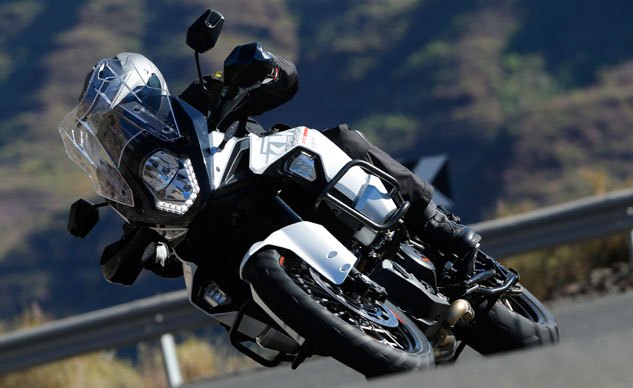
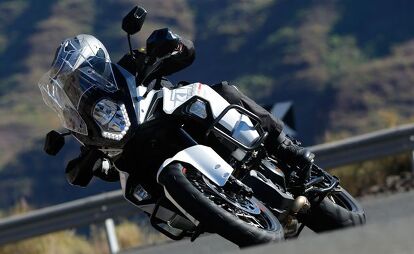































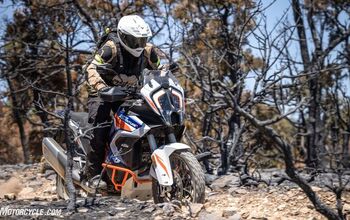
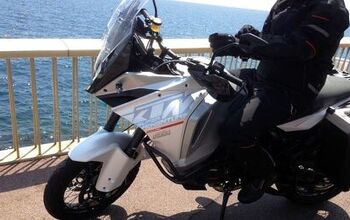
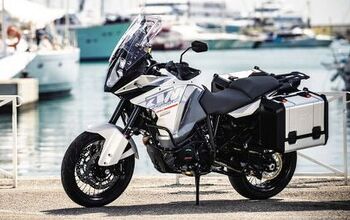












Comments
Join the conversation
You gave the 1290 a 92.75/100 Editor's Score. What motorcycle received the highest Editor's Score ever and what was that score?
I got my first KTM this year. I got the 350 EXC-F. I like it a lot. I guess I am going to go pick up one of these for longer rides. The 350's seat is not going to be comfortable after a couple hours.